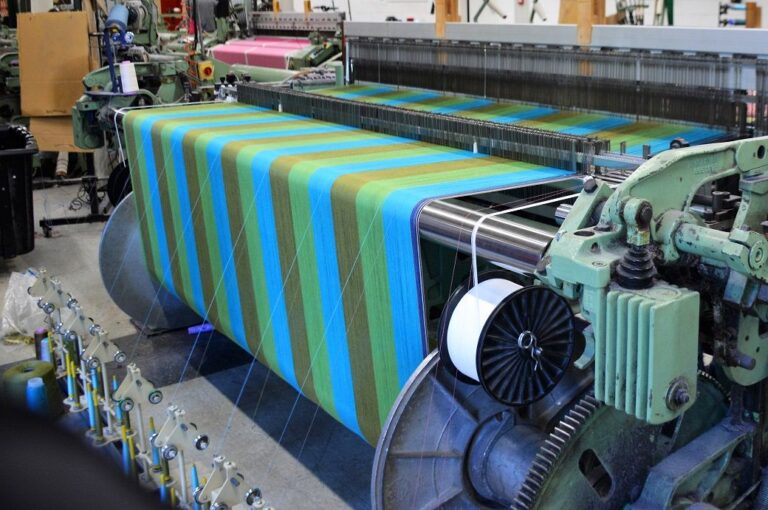
[ad_1]
Initially, the government had proposed to raise Basic Customs Duty (BCD) on all textile machinery, spares and accessories, but following demand from industry organisations, it decided to retain the rates. The Indian Budget 2023-24 had increased the duty on all textile machinery, spares and accessories from 5 per cent to 7.5 per cent, to be effective from April 1, 2023, to March 31, 2025. However, the industry had urged the government to retain BCD at 5 per cent, arguing that India depends on imports, except for spinning machinery, spares and accessories, which are essential to sustain global competitiveness with the high cost of capital in India.
India has reduced customs duty on textile machinery, spares, and accessories, including bringing shuttleless looms under the category of zero rate of duty.
The government had proposed to increase BCD in Budget 2023-24.
However, the government decided to retain the rates of duty after industry organisations demanded it.
Industry has welcomed the move.
After the government proposed increasing the BCD, the industry submitted a post-budget memorandum appealing to revoke the decision. As a result, the government issued a notification on March 29, 2023, granting relaxation for certain key machinery, spares, and accessories, and bringing shuttleless looms under nil rate of duty.
As per a notification issued by the Department of Revenue under the ministry of finance, the BCD has been decreased to zero for the following goods under HS codes 8446 and 8448 (other than old and used) for use in the textile industry, namely: (i) Shuttleless Rapier Looms (above 650 rpm); (ii) Shuttleless Waterjet Looms (above 800 rpm); and (iii) Shuttleless Airjet Looms (above 1000 rpm) and parts and components for use in manufacturing of shuttleless looms.
However, BCD will be 5 per cent on weaving machines (other than old and used) under HS code 8446, for use in the textile industry, namely: (i) Carbon Fabric Weaving Rapier Looms; (ii) Biaxial and multiaxial weaving machines for manufacturing technical textiles; and (iii) 3-D and block weaving machines for manufacturing technical textiles.
BCD will also be 5 per cent on the knitting machines (other than old and used) under HS code 8447, for use in the textile industry, namely: (i) Flat Knitting Machines (11 revolutions per minute or minimum speed of 0.3 Mts per sec); (ii) Warp Knitting Machines (Minimum working width of 60″ and minimum speed of 500 RPM); (iii) Raschel Knitting Machines (Minimum working width of 60″ and minimum speed of 500 RPM); (iv) Knitting machines for spacer fabrics.
The notification lists the following goods (other than old and used), for use in the textile industry, that fall in the 5 per cent duty category, (i) Industrial sewing machine (tariff heading 8452); (ii) Laser garment panel cutter (tariff item 8456 11 00); (iii) Whole garment making machine (knitted) (chapter 84); and (iv) Ink Jet printing machines (tariff item 8443 39 10).
The duty will also be 5 per cent on machinery (other than old and used) for manufacture of nonwovens textiles, namely: (i) Complete production lines for the production of following nonwovens, up to rolled goods preparation and packing, including (a) Needle punched nonwovens, (b) Chemically bonded nonwovens, (c) Thermally bonded nonwovens, (d) Stitch bond nonwovens, (e) Spun laced (hydro entangled) nonwovens, (f) Melt blown nonwovens, (g) Spun bond melt blown (SMS) nonwovens, (ii) Machinery for finishing of all nonwovens; and (iii) Machinery for converting nonwovens into made-ups.
The Southern Indian Mills Association (SIMA) has praised the move and hoped it will boost investment in the textile industry. Ravi Sam, chairman of SIMA, said in a statement that the weaving segment has been the weakest link in the entire textile value chain, next to the processing sector. The weaving sector is predominantly in the decentralised sector, and the country has hardly 10 per cent looms in the shuttleless looms category, resulting in lower value addition and high cost of production.
Sam added that although the EPCG scheme is in existence to facilitate the import of textile machinery at nil rates, with the high volatility in supply and demand, the industry could not fulfil the export obligation within the prescribed time, resulting in difficulties. He informed that BCD for several specialty weaving machinery, knitting machinery, sewing machinery parts, components, etc., classified under certain tariff headings, have been reduced from 7.5 per cent to 5 per cent. He hoped that the decision will enhance the global competitiveness for the weaving, knitting, garmenting, and technical textiles segments to a certain extent.
The new customs duty will be in effect till March 31, 2025, the notification said.
Fibre2Fashion News Desk (KUL)
[ad_2]
Source link